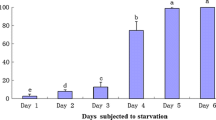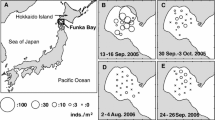Abstract
Anchovy larvae, Engraulis mordax, were reared in the laboratory under a variety of food regimes and the triacylglycerol, cholesterol, and polar lipid contents of individual larvae were measured with the Iatroscan thin-layer chromatography/flame ionization detection (TLC/FID) system, as indicators of nutritional condition. The different food levels used in the rearings produced a clear effect on the larvae for each of the three lipid components. A comparison with field-caught larvae, which were otolith-aged and analyzed for lipid content, showed that a “standard” laboratory rearing produced larvae with a much too high lipid content. Larvae could be reared in the laboratory to have a sizespecific lipid content similar to the field individuals, but this required that the food concentration be very much lower. When group of larvae were starved, the triacylglycerol component decreased first, regardless of the size of the store at the onset of starvation. The polar lipid component was not as labile as triacylglycerol, while the cholesterol content remained essentially unchanged during starvation. The cholesterol and polar lipid contents exhibited a good straight-line relationship with the lipid-free weight of the larvae, as would be expected from indicators of larval tissue weight. The results revealed the lipid components to be very good indicators of the condition of the larvae.
Similar content being viewed by others
Literature cited
Ackman, R. G. (1981). Flame ionization detection applied to thinlayer chromatography on coated quartz rods. Meth. Enzym. 72D: 205–252
Arthur, D. K. (1980). Differences in heart size between oceancaught and laboratory-reared larvae of the northern anchovy, Engraulis mordax. Girard. J. exp. mar. Biol. Ecol. 43: 99–106
Beers, J. R., Stewart, G. L. (1967). Micro-zooplankton in the euphotic zone at five locations across the California Current. J. Fish. Res. Bd Can. 24: 2053–2068
Beers, J. R., Stewart, G. L. (1969) Micro-zooplankton and its abundance relative to larger zooplankton and other seston components. Mar. Biol. 4: 182–189
Blaxter, J. H. S. (1971). Feeding and condition of Clyde herring larvae. Rapp. P. v. Réun. Cons. perm. int. Explor. Mer 160: 129–136
Blaxter, J. H. S., Ehrlich, K. F. (1974). Changes in behaviour during starvation of herring and plaice larvae. In: Blaxter, J. H. S. (ed.) Early life history of fish. Springer-Verlag, Heidelberg/Berlin, p. 575–588
Bligh, E. G., Dyer, W. J. (1959). A rapid method of total lipid extraction and purification. Can. J. Biochem. Physiol. 37: 911–917
Brothers, E. B., Mathews, C. P., Lasker, R. (1976). Daily growth increments in otoliths from larval and adult fish. Fish. Bull. U.S. 74: 1–8
Buckley, L. J. (1984). RNA-DNA ratio: an index of larval fish growth in the sea. Mar. Biol. 80: 291–298
Buckley, L. J. (1987). Recent growth, biochemical composition, and prey field of larval haddock (Melanogrammus aeglefinus) and Atlantic cod (Gadus morhua) on Georges Bank. Can. J. Fish. aquat. Sciences 44: 14–25
Ehrlich, K. F. (1974). Chemical changes during growth and starvation of herring larvae. In: Blaxter, J. H. S. (ed.) Early life history of fish. Springer-Verlag, Heidelberg/Berlin, p. 301–323
Ehrlich, K. F. (1975). A preliminary study of the biochemical composition of sea-caught larval herring and plaice. Comp. Biochem. Physiol. 51B: 25–28
Ehrlich, K. F., Blaxter, J. H. S., Pemberton, R. (1976). Morphological and histological changes during growth and starvation of herring and plaice larvae. Mar. Biol. 35: 105–118
Fraser, A. J., Sargent, J. R., Gamble, J. C., MacLachlan, P. (1987). Lipid class and fatty acid composition as indicators of the nutritional condition of larval Atlantic herring. Am. Fish. Soc. Symp. 2: 129–143
Fraser, A. J., Tocher, D. R., Sargent, J. R. (1985). Thin-layer chromatography-flame ionization detection and the quantification of marine neutral lipids and phospholipids. J. exp. mar. Biol. Ecol. 88: 91–99
Håkanson, J. L. (1984). The longterm and shortterm feeding condition in field-caught Calanus pacificus, as determined from the lipid content. Limnol. Oceanogr. 29: 794–804
Håkanson, J. L. (1987). The feeding condition of Calamus pacificus and other zooplankton in relation to phytoplankton pigments in the California Current. Limnol. Oceanogr. 32: 881–894
Håkanson, J. L. (1989). Condition of larval anchovy (Engraulis mordax) in the Southern California Bight, as measured through lipid analysis. Mar. Biol. 102: 153–159
Hunter, J. R. (1972). Swimming and feeding behavior of larval anchovy, Engraulis mordax. Fish. Bull. U.S. 70: 821–838
Hunter, J. R. (1976). Culture and growth of northern anchovy, Engraulis mordax, larvae. Fish. Bull. U.S. 74: 81–88
Kiørboe, T., Munk, P. (1986). Feeding and growth of larval herring, Clupea harengus, in relation to density of copepod nauplii. Envir. Biol. Fish. 17: 133–139
Lasker, R. (1975). Field criteria for survival of anchovy larvae; the relation between inshore chlorophyll maximum layers and successful first-feeding. Fish. Bull. U.S. 73: 453–462
Lasker, R. (1978). The relation between oceanographic conditions and larval anchovy food in the California Current: identification of factors contributing to recruitment failure. Rapp. P. v. Réun. Cons. perm. int. Explor. Mer 173: 212–230
Lasker, R., Feder, H. M., Theilacker, G. H., May, R. C. (1970). Feeding, growth and survival of Engraulis mordax larvae reared in the laboratory. Mar. Biol. 5: 345–353
Methot, R. D., Kramer, D. (1979). Growth of northern anchovy larvae, Engraulis mordax, in the sea. Fish. Bull. U.S. 77: 413–423
O'Connell, C. P. (1976). Histological criteria for diagnosing the starving condition in early post yolk sac larvae of the northern anchovy, Engraulis mordax Girard. J. exp. mar. Biol. Ecol. 25: 285–312
O'Connell, C. P. (1980). Percent of starving northern anchovy (Engraulis mordax) in the sea as estimated by histological methods. Fish. Bull. U.S. 78: 475–489
Ohman, M. D. (1988). Sources of variability in measurements of copepod lipids and gut fluorescence in the California Current coastal zone. Mar. Ecol. Prog. Ser. 42: 143–153
Øiestad, V., Moksness, E. (1981). Study of growth and survival of herring larvae (L.) using plastic bag and concrete enclosure methods combined. Rapp. P.v. Réun. Cons. perm. int. Explor. Mer 178: 144–149
Shelbourne, J. E. (1957). The feeding and condition of plaice larvae in good and bad plankton catches, J. mar. biol. Ass. U.K. 36: 539–552
Theilacker, G. H. (1978). Effect of starvation on the histological and morphological characteristics of jack mackerel, Trachurus symmetricus larvae. Fish. Bull. U.S. 76: 403–414
Theilacker, G. H. (1980). Changes in body measurements of larval northern anchovy, Engraulis mordax, and other fishes due to handling and preservation. Fish. Bull. U.S. 78: 685–692
Tocher, D. R., Fraser, A. J., Sargent, J. R., Gamble, J. C. (1984). Lipid class composition during embryonic and early larval development in Atlantic herring (Clupea harengus, L). Lipids 20: 84–89
Umeda, S., Ochiai, A. (1975). On the histological structure and function of digestive organs of the fed and starved larvae of the yellowtail, Seriola quinqueradiata. Jap. J. Ichthyol. 21: 213–219
Author information
Authors and Affiliations
Additional information
Communicated by P. C. Schroeder, Pullman
Rights and permissions
About this article
Cite this article
Håkanson, J.L. Analysis of lipid components for determining the condition of anchovy larvae, Engraulis mordax . Mar. Biol. 102, 143–151 (1989). https://doi.org/10.1007/BF00428274
Accepted:
Issue Date:
DOI: https://doi.org/10.1007/BF00428274




